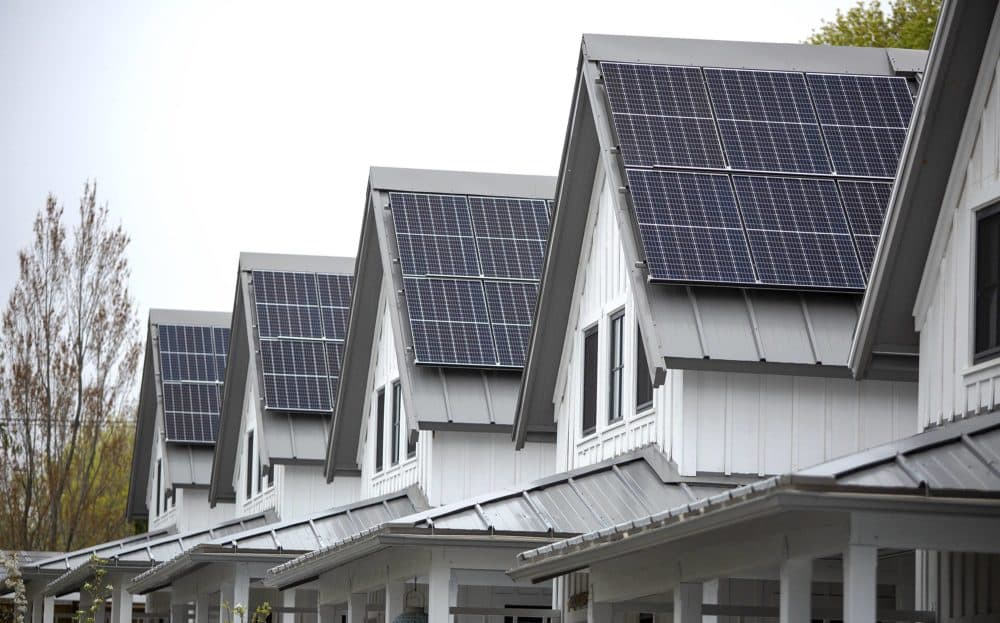Wildfire smoke ‘significantly’ reduced solar power production in New England this week

Solar panels on the rooftops of passive house buildings at the Hillside Center. (Robin Lubbock/WBUR)
The smoke from Canadian wildfires didn’t just block the sun and make the air unhealthy to breathe in much of New England this week. It also blunted solar power production and made it harder to forecast electricity demand in the region, according to the regional grid operator.
“At a simple level, the smoke is is inhibiting the solar power from hitting the panels and generating electricity,” said Matt Kakley, a spokesperson for ISO New England, which manages the grid. And because most solar power in New England is “behind the meter” — on rooftops and used directly in homes or businesses — when production falls off, demand on the regional grid increases.
At the same time, the smoke caused temperatures to drop a bit lower than forecasted, which meant people used less electricity than expected.
“So you have these two conflicting things going on. One is reducing demand on the system and the other is increasing demand on the system, and neither are showing up in our weather forecasting,” Kakley said.
One of ISO New England’s jobs is to balance supply and demand on the electrical grid. To do this, it relies on sophisticated computer models and weather forecasts that work in real-time to predict how much power people will use and make sure the region’s power generators can supply it. The problem is those models aren’t built to take wildfire smoke into account.
“When we forecast demand on the system, we’re looking at historical data,” Kakley said. “And the challenge with something like this is that there’s just simply not the historical data that you would have to to look back on.”
Other grid operators on the East Coast, like those in charge of New York and the Mid-Atlantic region, also reported lower than expected solar power output thanks to the smoke.
“From ISO New England’s perspective, this is an opportunity to get a little bit of data on things,” Kakley said. “We saw this a little bit last year with wildfire smoke that had come over from California. But this current situation is a little more severe.”
Solar forecasting on any given day is incredibly complicated, and a dip in production could be the result of several factors — for example, how much of the gap was because the clouds were a little thicker than forecasted, and how much of it was smoke? Kakley said ISO New England experts are still analyzing what happened this past week and cannot yet provide specific information about how solar production was impacted by the smoke other than to say it was “significant.”
That said, this week’s diminished solar production didn’t threaten electrical reliability on the system, in part because solar power isn’t currently a huge source of electricity in New England. The region has about 283,000 distributed solar installations that are capable of generating about 5,500 megawatts of power; by contrast, the grid has about 31,000 megawatts of potential power production.
But solar is growing quickly — ISO New England predicts it will double in capacity within the next decade — so the threat of unpredictable wildfire smoke like this could pose a bigger risk in the future as the planet continues to warm.
“Climate change is going to cause more and more of these kinds of issues,” said Kyle Murray, the Massachusetts program director of the Acadia Center, a clean energy advocacy group.
At this point, it’s hard to say that human-induced climate change is directly causing the wildfires in Eastern Canada, but it certainly makes the sort of drought and hotter-than-average temperatures that lead to wildfires more likely.
As the smoke from the Canadian wildfires continues to dissipate over New England, Murray said he sees two big takeaways: First, New England needs to stop making the climate problem worse by burning fossil fuels. And second, it needs to build a more modern and flexible grid that relies on multiple sources of renewable energy.
“We need to learn strategies for how to mitigate [impacts] and how to think creatively going forward because the problem isn’t going away,” Murray said.
This story was originally published by WBUR, a partner of the New England News Collaborative.

